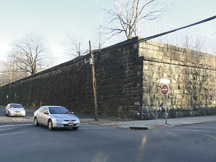A developer who wants to build housing and parkland at the site of an old railroad embankment will have his application to demolish the embankment heard by the city’s Historic Preservation Commission on March 2.
However, Steve Hyman, the developer, has been touting an alternative plan that allows him to preserve most of the embankment and still build a residential tower on a portion of the property. He has said that if the city endorses his newer plan, he may not need to demolish the entire railroad structure.
The Sixth Street Embankment is a series of sandstone and granite blocks spanning Sixth Street downtown from Marin Boulevard to Brunswick Street, over which a section of the Pennsylvania Railroad freight line ran from 1902 until the late 1970s.
Hyman acquired the property in 2005 from Conrail for $3 million. At first, he wanted to demolish the embankment and build two-family homes. After protests from community activists, he came up with a new plan to leave 75 percent of the 5.6-acre, six-block structure as open space, and for the remaining 25 percent to contain housing.
However, the city has not yet approved the new plan.
The application for the demolition was supposed to be heard by the city’s Historic Preservation Commission on Feb. 9, but the meeting was cancelled the same day and has been rescheduled for March 2.
Local park activists have pushed for the Embankment to be completely preserved, and possibly used for parks, recreation, and maybe a light rail extension. Mayor Jerramiah Healy has endorsed the activists’ suggestions.
Complicating the issue are questions about whether the railroad’s sale of the property to Hyman in 2005 was done according to the rules of the Surface Transportation and Safety Board (STB), which say that a railroad must offer its property for public use before selling it to a private owner.
Recently, the City Council passed a resolution to support pending state legislation to regulate future sales of railroad property to private developers. City officials also have met behind closed doors with the attorney retained to monitor the Embankment issue on the federal level on behalf of the city and the Embankment Coalition.
Sell to city first
The council’s resolution at its Feb. 11 meeting endorsed pending state legislation crafted by state Assemblyman (and former City Council President) L. Harvey Smith requiring railroad companies to negotiate “in good faith” with local governments first before they sell the rights to railroad lines they no longer operate to private entities.
The federal Surface Transportation Board (STB) ruled in August 2007 that Conrail should have gotten authorization from the STB to legally abandon the Embankment and offer it to public entities before it was sold to Hyman. This came out of a petition filed with the STB in January 2006 by the City of Jersey City, the Rails to Trails Conservancy, the Pennsylvania Railroad Harsimus Stem Embankment Coalition (Coalition), and then-State Assemblyman Louis M. Manzo to determine if Conrail went through the proper procedures in abandoning the Embankment before selling to Hyman.
The STB’s ruling would theoretically void the land sale to Hyman, but Conrail is still fighting the decision by filing exemptions with the STB to not have to go through the abandonment process.
During Wednesday’s council meeting, some members of the public supported the new resolution, and others opposed it.
Members of the Harsimus Stem Embankment Coalition, which since 1998 have advocated preservation and recreational use of the Embankment, exhorted the council to vote in favor of the resolution.
“This will ensure that a railroad will not make unreasonable demands on local government while offering sweetheart deals to a developer,” said Maureen Crowley, founder of the coalition.
However, lawyers for Hyman tried to convince the council not to endorse the legislation, saying it would hurt negotiations with the city to drop their current litigation contesting the STB decision and to allow for their development to go forward.
“We don’t need a statute to say the words ‘good faith’ [because] good faith has been exercised on every level with the Sixth Street Embankment and its disposition,” Hyman’s attorney, Carmine Alampi, told the council.
But the City Council, not easily swayed, voted 8-0 in favor of the resolution.
During the meeting, several council members said they would to like to see the Embankment issue resolved as soon as possible.
City Councilman Michael Sottolano said the legal costs are “too expensive” and that too much time is being spent on the matter.
Meeting with attorney
On Feb. 9, the City Council went into a closed caucus with railroad law attorney Charles Montange, who is monitoring the Embankment issue on the federal level.
Montange told the Jersey City Reporter before the closed caucus that he was planning to update the council on a recent STB decision. On Jan. 26, the STB denied two requests from Conrail to waive certain requirements they would have had to face related to selling the Embankment.
Dan Horgan, one of Hyman’s attorneys, issued a letter of protest at the Feb. 11 council meeting against the closed-door session with Montagne, saying the meeting with Montagne, along with the resolution endorsing the state legislation, would hinder efforts to resolve the Embankment issue.
Instead, City Councilman Bill Gaughan brushed off the letter, noting that Montagne has worked for the city and the Embankment Coalition for nearly three years and it had never been a problem before.
Ricardo Kaulessar can be reached at rkaulessar@hudsonreporter.com.
